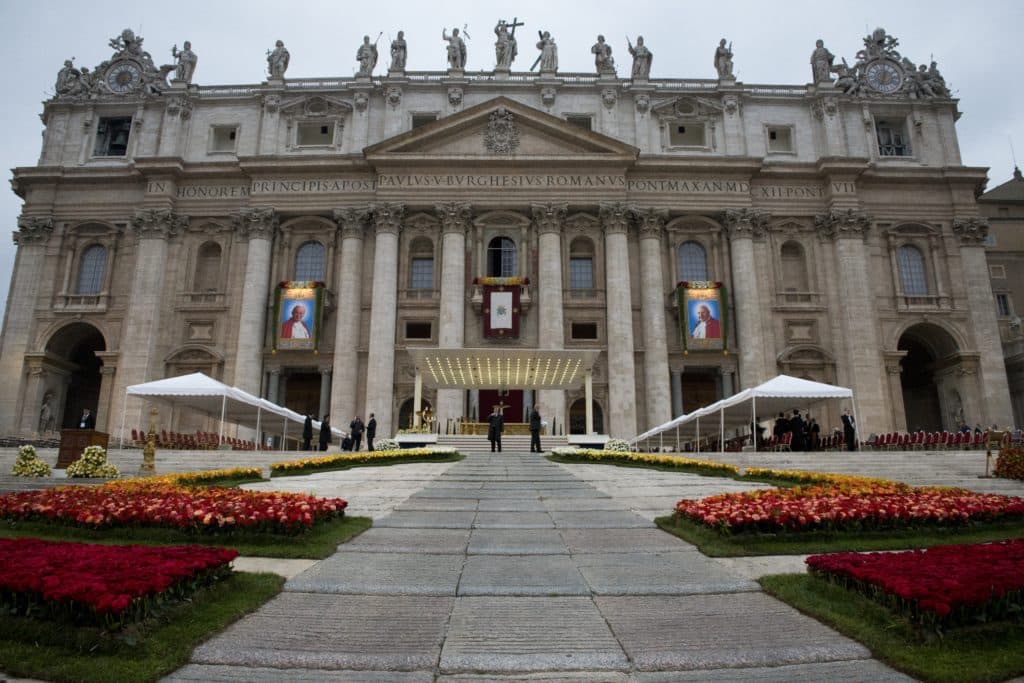Episcopal Canonization (began in 300s)
Local bishops would recognize martyrs or deceased confessors (saints who were not martyred) within their diocese by confirming the cultus of the person and often by doing so by erected an altar over their grave or by placing their remains/relics within an altar.
Metropolitan Canonizations (began in 400s)
By the time of Saint Augustine (d. 430), the process required the further ratification of the metropolitan archbishop of the province to which the saint belonged. (A province is a collection of dioceses within a Roman province headed by a metropolitan archbishop.)
The last Metropolitan canonization of a saint occurred in AD 1153 with the canonization of Saint Walter of Pontoise by the Archbishop of Rouen. After this, Popes in Rome reserved the right to canonize saints.
Papal Canonization (began in AD 993)
As the Church gained more political power, Catholic royalty would press bishops to canonize their kinfolk and ancestors so as to prop up their political standing as being holy and beneficent. It better establishes your crown if dad or granddad is a venerated saint.
Popes as Bishops of Rome had canonized Roman saints. But AD 993 marks the first papal canonization outside Roman territory with that of Saint Udalric, Bishop of Augsburg (and belonging to the family of the Ottonian dynasty) by Pope John XV.
Pope Alexander III decreed in 1170 that the canonization of saints was reserved to the Pope alone after investigation.
Pope Benedict XIV (1740 – 1758) established the procedure for papal canonizations. Since 1983, under John Paul II, the process looks like this:
- Servant of God – person submitted by local bishop to Rome for consideration
- Venerable – Rome formally recognizes the heroic virtue of the person. The person is not said to be in Heaven, does not receive a feast day, and churches or shrines cannot be dedicated to this person. However, prayer cards can be printed and distributed.
- Blessed – This is the papal approval for a local diocesan cult. One confirmed miracle through the post-mortem intercession of the person is required.Beatification confirms officially that it is “worthy of belief” that the Venerable is in Heaven and saved. A feast day is assigned to the Blessed but it is restricted to the home diocese of the Blessed and not to the universal Church.
- Saint – This is the papal approval for a universal cultus of the person. A total of two miracles are required (one more after the beatification miracle). The feast day is universal and parish churches, cathedrals and shrines may be named after the saint. Canonization confirms that the person certainly enjoys the Beatific Vision of Heaven.
Equipollent (Papal) Canonization (began in late 1500s)
Beginning in the late 1500s, Popes also recognized an form of papal canonization known as “equipollent canonization.” Equipollent means “equal in power.” These canonization do not require a formal process of canonization or miracles. Rather, equipollent canonizations recognize an already large, ancient and thriving cultus to a deceased and miraculous Christian person. Here are the conditions:
- existence of an ancient cultus of the person
- a constant attestation to the virtues or martyrdom of the person
- uninterrupted fame as a worker of miracles
Examples include these equipollent saints:
- Bruno
- Raymond Nonnatus (literally “not born”)
- Stephen of Hungary
- Margaret of Scotland
- Wenceslaus of Bohemia
- Peter Damian
- Boniface
- Cyril and Methodius
- Ephrem the Syrian
- Albert the Great
- John of Ávila
- Hildegard of Bingen
- Gregory of Narek
There has been increase in equipollent canonizations: 18 or so in the last 100 years. My guess is that this will reduce over time as most canonized saints are more recent and will likely go through the now established papal canonization process.
All Saint, pray for us,
Taylor Marshall, PhD



Comments Policy: I reserve the right to delete comments that are offensive or off-topic. If your comment contains a hyperlink to another site, your comment automatically goes into "Comments Purgatory" where it waits for release by way of moderation.